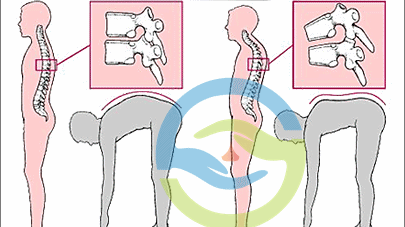Get the App
For Doctors
Login/Sign-up
Last Updated: Aug 29, 2019
BookMark
Report
What Is Kyphosis Disease?
What Is Kyphosis Disease?
Kyphosis is an exaggerated, forward rounding of the back. It can occur at any age but is most common in older women.
Age-related kyphosis is often due to weakness in the spinal bones that causes them to compress or crack. Other types of kyphosis can appear in infants or teens due to malformation of the spine or wedging of the spinal bones over time.
Mild kyphosis causes few problems. Severe kyphosis can cause pain and be disfiguring. Treatment for kyphosis depends on your age and the cause and effects of the curvature.
Types of Kyphosis:
*Postural kyphosis:
Postural kyphosis is a condition resulting from poor posture and muscles that have become weak and tight. Treatment: This specific condition can be treated by a number of things. Exercises such as yoga poses, chest stretches, and weighted exercises can help strengthen your back, neck, and shoulder muscles. Physical therapy is also a tool used to help treat postural kyphosis. Finally, a posture brace specifically for posture correcting can not only help ease your kyphosis pain but when used early, can help prevent it. Here at BraceAbility, we have a wide selection of posture correcting braces that are adjustable and customizable specifically for you.
*Scheuermann’s Disease:
Scheuermann’s Disease is a deformity in the thoracic or upper part of your spine. This causes an abnormality that makes the vertebrae grow at different rates during adolescence. Treatment: Since this type occurs in children while they are growing, a back brace is usually used to help stop the curve from bending more. Depending on the severity of your child’s case or at the beginning stages, it is recommended to wear this brace for almost all of their day. Another treatment option for this disease is different strengthening exercises and physical therapy. For severe cases, surgery is used to help treat individuals with an abnormal curve of over 75 degrees or if they have extreme pain.
*Degenerative kyphosis:
Degenerative kyphosis is a loss of normal disc height from overuse or aging. This causes the discs in your spine to angle forward. Treatment: If you are experiencing pain, initially start with conservative treatments such as physical therapy, chiropractor visit, anti-inflammatory medicines, and strengthening of the core and back muscles. If this pain persists, surgery may be an option.
*Neuromuscular kyphosis:
Neuromuscular kyphosis usually occurs in individuals that have cerebral palsy, spina bifida, or muscular dystrophy. Treatment: Based on the individual, surgery or back brace support may be an option.
*Nutritional kyphosis:
Nutritional kyphosis is caused by dietary and nutritional deficiencies. It is common for children and adults but more likely in elderly individuals. This type of kyphosis can be prevented with a well-balanced diet. ingredients you’ve been missing.
*Iatrogenic kyphosis:
Iatrogenic kyphosis is a result of previous surgery. Treatment: Depending on severity, another surgery may be required to help fix the complication.
Causes of Kyphosis:
The individual bones (vertebrae) that make up a healthy spine look like cylinders stacked in a column. Kyphosis occurs when the vertebrae in the upper back become more wedge-shaped.
Abnormal vertebrae can be caused by:
*Fractures: Broken or crushed vertebrae (compression fractures) can result in curvature of the spine. Mild compression fractures often don't produce noticeable signs or symptoms.
**Osteoporosis: This bone-thinning disorder can cause spinal curvature, especially if weakened vertebrae result in compression fractures. Osteoporosis is most common in older women and people who have taken corticosteroids for long periods of time.
*Disk degeneration: Soft, circular disks act as cushions between spinal vertebrae. With age, these disks dry out and shrink, which often worsens kyphosis.
*Scheuermann's disease: Also called Scheuermann's kyphosis, this disease typically begins during the growth spurt that occurs before puberty. Boys are affected more often than girls.
**Birth defects: Spinal bones that don't develop properly before birth can cause kyphosis.
*Syndromes: Kyphosis in children can also be associated with certain syndromes, such as Ehlers-Danlos syndrome and Marfan syndrome.
**Cancer and cancer treatments: Cancer in the spine can weaken vertebrae and make them more prone to compression fractures, as can chemotherapy and radiation cancer treatments.
Symptoms:
Mild kyphosis may produce no noticeable signs or symptoms. But some people experience back pain and stiffness in addition to an abnormally curved spine.
Diagnosis:
Your doctor will generally conduct a thorough physical examination, including checking your height. You may be asked to bend forward from the waist while your doctor views your spine from the side. Your doctor might also perform a neurological exam to check your reflexes and muscle strength.
After evaluating your signs and symptoms, your doctor may recommend:
X-rays or CT scans. X-rays can determine the degree of curvature and detect deformities of the vertebrae. A CT scan might be recommended if your doctor wants more-detailed images.
MRI. These images can detect infection or a tumor in your spine.
Nerve tests. If you are experiencing numbness or muscle weakness, your doctor may recommend tests to determine how well nerve impulses are traveling between your spinal cord and your extremities.
Bone density tests. Low-density bone can worsen kyphosis.
Role of Homeopathy in Kyphosis:
The symptoms were effectively treated with different potencies of a single homeopathic drug, Calcarea Phos. X-ray and magnetic resonance imaging (MRI) supported recovery and a change in the skeletal curvature that was accompanied by removal of pain and other acute symptoms of the ailment.
Diet and Non-Diet food:
For calcium to reach optimal absorption it should be paired with foods rich in Vitamin D and Magnesium. Green leafy vegetables such as kale, collard greens, and broccoli have as much calcium as cows milk yet are more readily absorbed by the body. Good sources of Vitamin D are mushrooms and salmon.
In case you have a concern or query you can always consult a specialist & get answers to your questions!



+1.svg)
